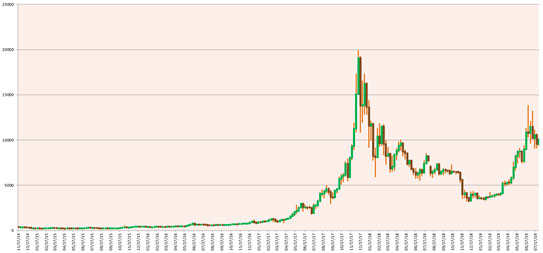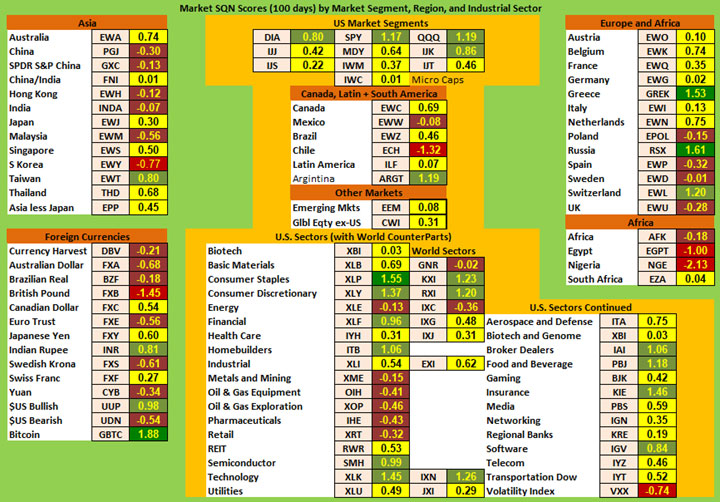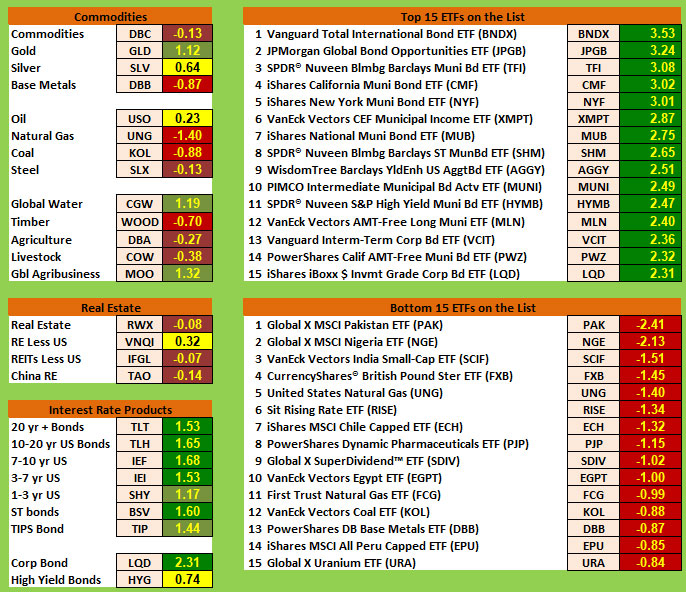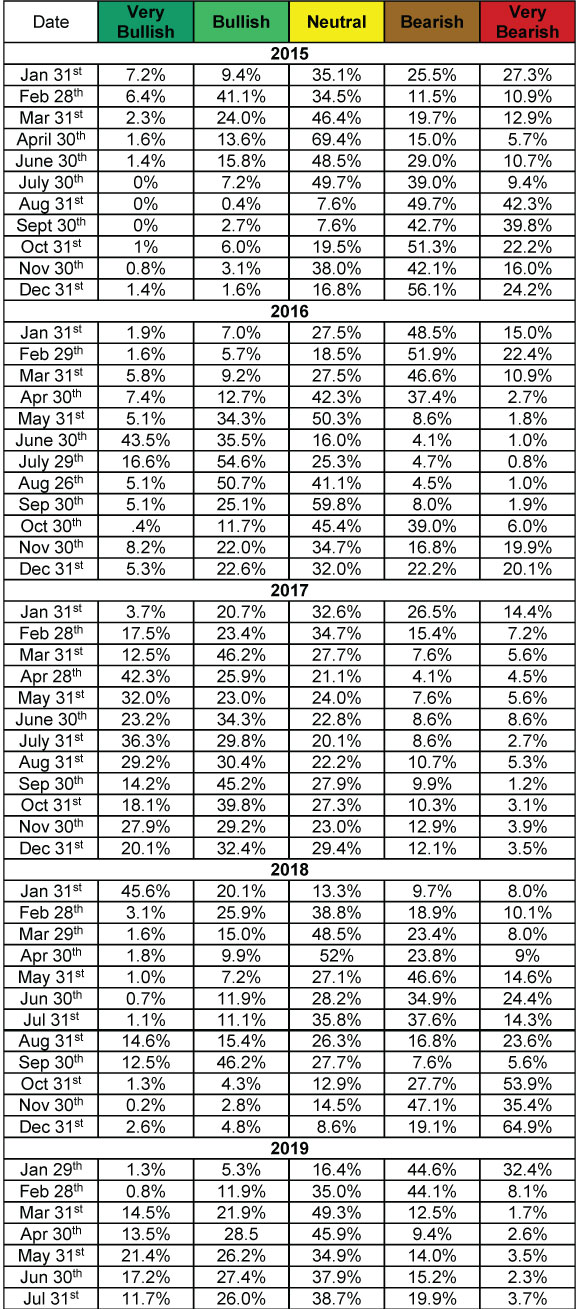 There are numerous ETFs that track everything from countries, commodities, currencies and stock market indices to individual market sectors. ETFs provide a wonderfully easy way to discover what’s happening in the world markets. I apply a version of my System Quality Number® (SQN®) score to measure the relative performance of numerous markets in a world model.
There are numerous ETFs that track everything from countries, commodities, currencies and stock market indices to individual market sectors. ETFs provide a wonderfully easy way to discover what’s happening in the world markets. I apply a version of my System Quality Number® (SQN®) score to measure the relative performance of numerous markets in a world model.
The Market SQN score uses the daily percent change for input over a 100-day period. Typically, a Market SQN score over 1.47 is strongly bullish and a score below -0.7 is very weak. The following color codes help communicate the strengths and weaknesses of the ETFs in this report:
- Dark Green: ETFs with very strong Market SQN scores > 1.47
- Light Green: ETFs with strong Market SQN scores (0.70 to 1.47).
- Yellow: ETFs with slightly positive Market SQN scores (0 to 0.70). These are Neutral/Sideways
- Brown: ETFs with slightly negative Market SQN scores (0 to -0.7).
- Red: Very weak ETFs that earn negative Market SQN scores (< -0.7).
This is basically the same rating scale that we use for the Market SQN Score in the Market Update. The world market model spreadsheet report below contains a cross section of currently available ETFs; excluding inverse funds and leveraged funds. In short, it covers equity markets around the globe, major asset classes, equity market segments, industrial sectors, and major currencies.
World Market Summary — Equities & Currencies
Each month we look at the equities markets across the globe by segment, region, and sector.
The market had started to look much better, but as with last month’s table, the model looks rather neutral still with a lot of yellow, some greens but just as many browns and red.
In currencies, the US Dollar is at the top of its trading range where it has been since the 3rd quarter of last year. It was up for July and it may break out soon or may go back into its current range. The USD ETF is light green as is the Indian Rupee ETF. The British Pound is the only strongly bearish currency this month which probably has to do with the new prime minister and Brexit. Nearly all of the other currencies are either mildly bullish or mildly bearish.
Bitcoin is the only dark green currency this month. In our market model, we track Bitcoin using GBTC. It’s easy to see what is happening from the Bitcoin weekly price bar chart below from 2014 to the present. Watch my mid-month update on cryptos for more information.

In US equities, the large caps (top row in center table) are now all green whereas the other segments of US Equities are yellow except for mid-cap growth (IJK) which is green.
In the Americans, Argentina is bullish but everything else is neutral or weak except for Chile which in a strong bear mode.

In Asia, only Taiwan is green. Australia, China/India, Japan, Singapore, Thailand, and Asia less Japan are neutral. Everything else is brown except for South Korea which became even more bearish in July.
In Europe, Greece and Russia are dark green while Switzerland is light green. About half of the European countries are yellow with the remaining third or so mildly bearish (brown). Nothing in Europe, though, is red.
In Africa, the overall continent is bearish, South Africa is neutral and Nigeria is one of the weakest ETFs for the month.
If we look at the US sectors, we have only Consumer Staples as being strong bull. Consumer Discretionary, Financial, Homebuilders, Semiconductors, Technology, Broker Dealers, Food and Beverage, Insurance, and Software are all light green or mildly bullish. There are, however, a number of bearish sectors including: Energy, Metals and Mining, Oil / Gas Equipment and Exploration, Pharmaceuticals, and Retail. Because of the quiet volatility in the markets, the only strong bear sector ETF is volatility (VXX which is based on the VIX).
Commodities, Real Estate, Debt, and the Top and Bottom Lists

Commodities are mixed with a bearish tendency. Base Metals, Natural Gas, Coal, and Timber are all strong bear commodities. Steel, Agriculture, and Livestock are all mildly bearish. Silver and Oil are both neutral while Gold, Global Water, and Global Agribusiness are strongly bullish.
Real estate ETFs are either slightly positive or slightly negative.
With the exception of junk, all of the bond ETFs are bullish or strong bull.
What’s really interesting on the top 15 list is that all of them dark green like last month. Last month the lowest ranking of the top 15 was 3.71 and this month you need 2.41 to make the top 15.
Everything in the top 15 has to do with interest rates and most are muni ETFs of some kind. GBTC didn’t make the top 15 as it has a Market SQN score right now of just under 2.0.
On the bottom list, all 15 are red and the worst is Pakistan at minus 2.41. Pakistan and Nigeria make the top two. Natural gas issues are among the bottom 15 along with some countries and other miscellaneous areas.
Summary
Let’s look at the summary table which measures the percentage of ETFs in each of the strength categories. You can see the distribution of the database by Market SQN score in bullish, neutral and bearish categories below —

The percentage distribution of ETFs in the model confirms continuing market neutrality.
Be careful to base your actions upon what IS happening, not what you think might happen. The markets always offer opportunities, but to capture those opportunities, you MUST know what you are doing. If you want to trade these markets, you need to approach them as a trader, not a long-term investor. We’d like to help you learn how to trade professionally because trying to navigate the markets without an education is hazardous to your wealth. All the beliefs given in this update are my own. Though I find them useful, you may not. You can only trade your own beliefs about the markets.
